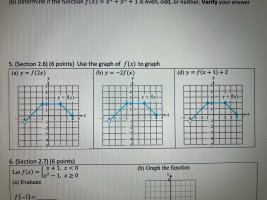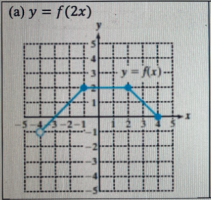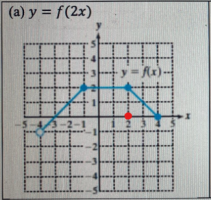Please help solve this problem!
- Thread starter aornel00
- Start date
blamocur
Elite Member
- Joined
- Oct 30, 2021
- Messages
- 3,205
READ BEFORE POSTING
Welcome to FreeMathHelp.com! Please take the time to read the following before you make your first post. It will help you to get your math questions answered promptly and in the most helpful manner. A summary is available here, but please read the complete guidelines below at your earliest...
www.freemathhelp.com
Dr.Peterson
Elite Member
- Joined
- Nov 12, 2017
- Messages
- 16,814
We ask you to show where you need help, rather than just implying you want us to do it all. I'll suppose that you can't even start.
I'll do one point for you, so you can see how to do it:
The easiest thing to do is just to recognize what transformation is represented by replacing x with 2x. (For that, read section 2.6 in your book!)
It's also helpful to give a name to the function you're graphing; let's say g(x) = f(2x).
But if you haven't seen that, you can look at each point. The rightmost point, (4,0), tells you that f(4) = 0. Then what value of x would make f(2x) be f(4)? That would be when x=2, right? So g(2) will be 0, since g(2) = f(2*2) = f(4) = 0.
Plot the point (2, 0):
Then repeat for other points, even the one with an open dot, because that means the graph approaches that point. Finally, draw the lines.
And then think about what you have done to the original graph, so you can think in terms of transformations next time.
I'll do one point for you, so you can see how to do it:
The easiest thing to do is just to recognize what transformation is represented by replacing x with 2x. (For that, read section 2.6 in your book!)
It's also helpful to give a name to the function you're graphing; let's say g(x) = f(2x).
But if you haven't seen that, you can look at each point. The rightmost point, (4,0), tells you that f(4) = 0. Then what value of x would make f(2x) be f(4)? That would be when x=2, right? So g(2) will be 0, since g(2) = f(2*2) = f(4) = 0.
Plot the point (2, 0):
Then repeat for other points, even the one with an open dot, because that means the graph approaches that point. Finally, draw the lines.
And then think about what you have done to the original graph, so you can think in terms of transformations next time.
Steven G
Elite Member
- Joined
- Dec 30, 2014
- Messages
- 14,591
I will like to add to the great post by Dr Peterson.
Look at key points, like where the graph changes.
The key points are at (-4,-1), (-1,2), (2,2) and (4,0). Now find the equivalent points for g(x), where g(x) = f(2x). For example, (4,0) becomes (2,0).
f(x), when x goes from -4 to -1 is a straight line. Find the 'equivalent' points to (-4,-1) & (-1,2) and draw a straight line between them.
Continue.
Look at key points, like where the graph changes.
The key points are at (-4,-1), (-1,2), (2,2) and (4,0). Now find the equivalent points for g(x), where g(x) = f(2x). For example, (4,0) becomes (2,0).
f(x), when x goes from -4 to -1 is a straight line. Find the 'equivalent' points to (-4,-1) & (-1,2) and draw a straight line between them.
Continue.



